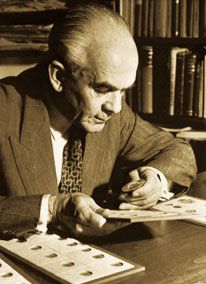Petrus Johann du Toit facts for kids
Quick facts for kids
Petrus Johann du Toit
|
|
|---|---|
 |
|
| Born | 16 March 1888 Somerset West
|
| Died | 13 November 1967 (aged 79) |
| Alma mater | Stellenbosch University |
| Known for | Genootskap van Regte Afrikaners |
| Awards | Fellow of the Royal Society (1951) |
Petrus Johann du Toit (born March 16, 1888 – died November 13, 1967) was an important South African scientist. He was a veterinary scientist, which means he studied animal health. He took over from Arnold Theiler as the leader of the Veterinary Services at Onderstepoort from 1927 to 1948. His father, Daniel Francois du Toit, was one of the people who started the Genootskap van Regte Afrikaners. This group was very important for the Afrikaans language.
Contents
Becoming a Scientist
After finishing school, Petrus du Toit went to Victoria College in Stellenbosch. He then traveled to Zurich where he earned a degree in zoology in 1912. Later, in 1916, he became a Doctor of veterinary science in Berlin.
He spent three more years studying diseases that affect farm animals in hot climates. He even wrote a book about these diseases called Tropenkrankheiten der Haustiere in 1921.
A Leader in Animal Health
Petrus du Toit was known for his amazing scientific skills early in his career. While the previous director, Arnold Theiler, often led all the research, du Toit was great at letting other talented scientists do their own work.
He was friendly and a brilliant speaker. This helped him join many important groups and committees. He played a big part in improving the role of science in South Africa and around the world.
Onderstepoort's Discoveries
The Onderstepoort Veterinary Institute made huge progress in understanding and controlling animal diseases. From 1908 to the 1950s, they found out what caused many diseases. They also created vaccines that helped stop these illnesses.
Some of the diseases they studied included:
- Lamsiekte (a type of botulism)
- Geeldikkop (a disease in sheep that causes yellow skin and swelling)
- African horsesickness
The institute also developed vaccines, and some of these were used all over the world. They started to think about animal health in a wider way. They realized that the condition of the land and pastures was very important for preventing diseases and keeping animals healthy.
Protecting African Research
In 1944, a group from the US asked du Toit for samples of a disease called heartwater. He said no because he believed that African scientists should be the ones to solve problems related to diseases found only in Africa.
He explained his decision by saying:
"I realize of course that a scientific problem can never be any one person's preserve; that competition and even duplication of work may sometimes be very desirable; and yet I feel that in this instance I ought to protect the men who have struggled against the odds and are beginning to see daylight in a very complicated problem, which is of immense economic importance to South Africa."
This shows he wanted to support the hard work of his team.
Big Achievements
Under the leadership of both Arnold Theiler and Petrus du Toit, the Onderstepoort Institute made huge contributions to veterinary science. They discovered the cause of lamsiekte in cattle and created a successful vaccine for African horse sickness.
By the end of the 1940s, two major animal diseases in Africa were almost gone:
- East Coast fever, which is spread by ticks.
- Nagana, which is spread by the tsetse fly.
Onderstepoort also led the way in studying phytotoxins, which are poisons from plants. During World War II, South Africa sent horse sickness vaccines to British forces in Egypt and the Middle East. They also helped stop the spread of rinderpest (a cattle disease) in Tanganyika.
Awards and Writings
Petrus du Toit was a very respected scientist. He held many important positions:
- He was President of the South African Veterinary Association for several years.
- He led the South African Biological Society.
- He was President of the Southern African Association for the Advancement of Science.
- He was also the Dean of the University of Pretoria Faculty of Veterinary Science.
He received many honors, including six honorary doctorates. He also became an honorary member of scientific groups in France, the United Kingdom, and Belgium.
He worked with Sir Arnold Theiler to understand what caused botulism in cattle. He also helped create vaccines for African horse sickness and bluetongue disease. He figured out that tiny insects called Culicoides were spreading these diseases.
Du Toit also helped develop vaccines against anthrax and botulism. He improved the way animals were protected against heartwater. In total, he wrote or helped write 132 scientific papers.

